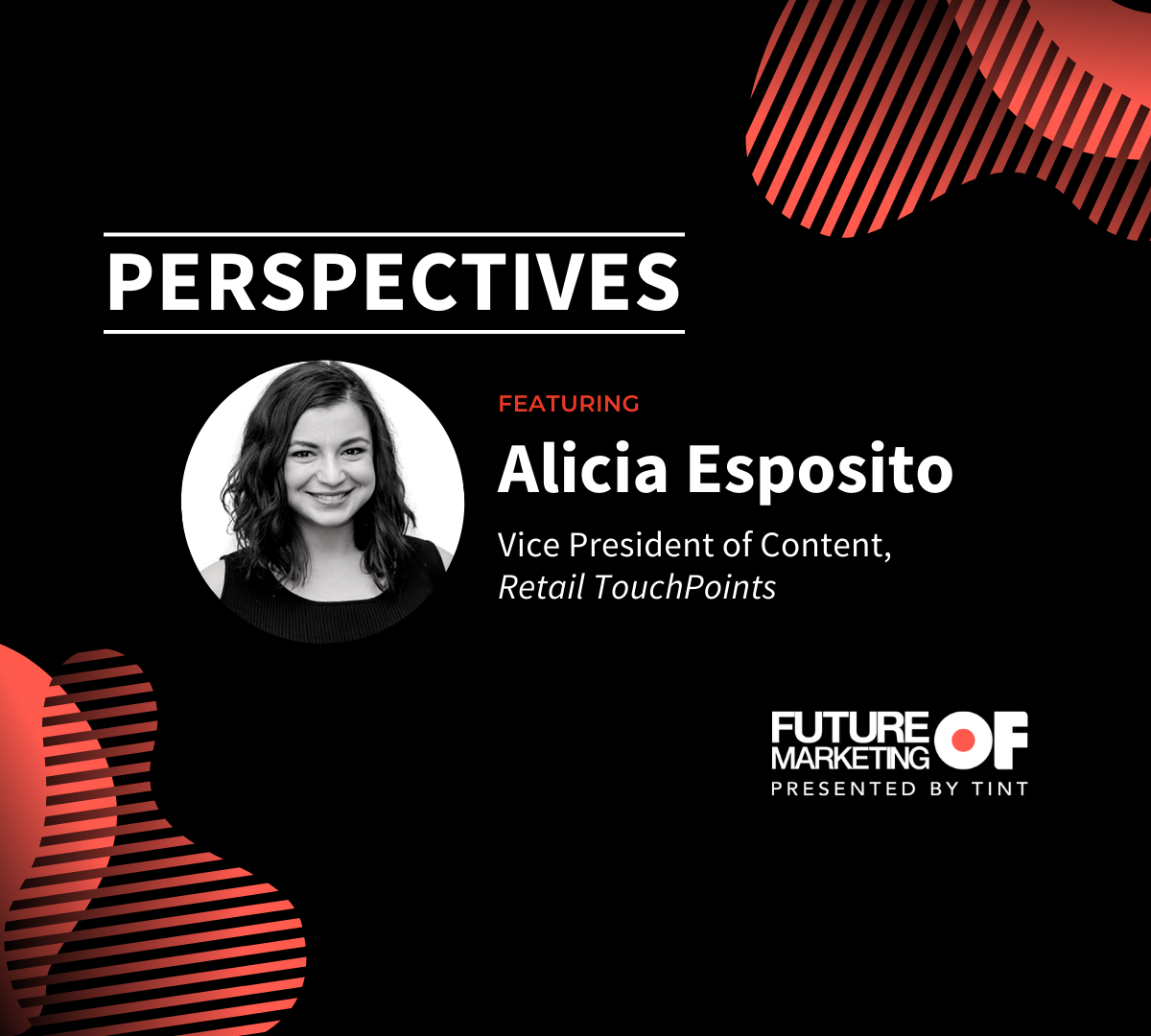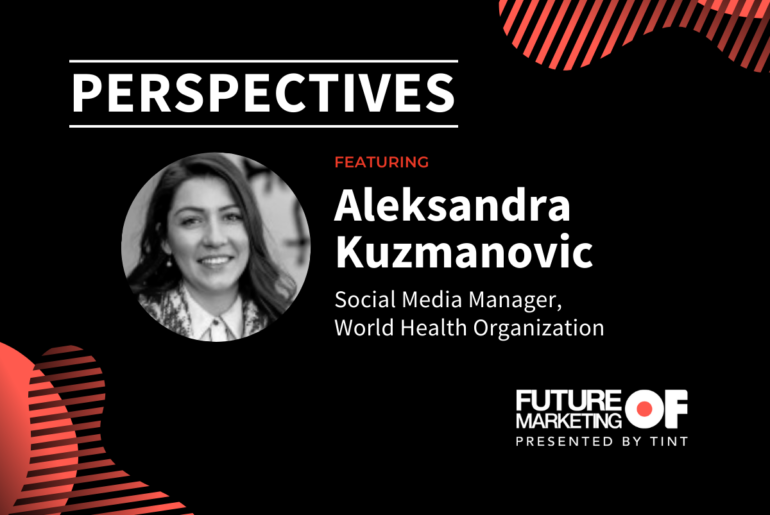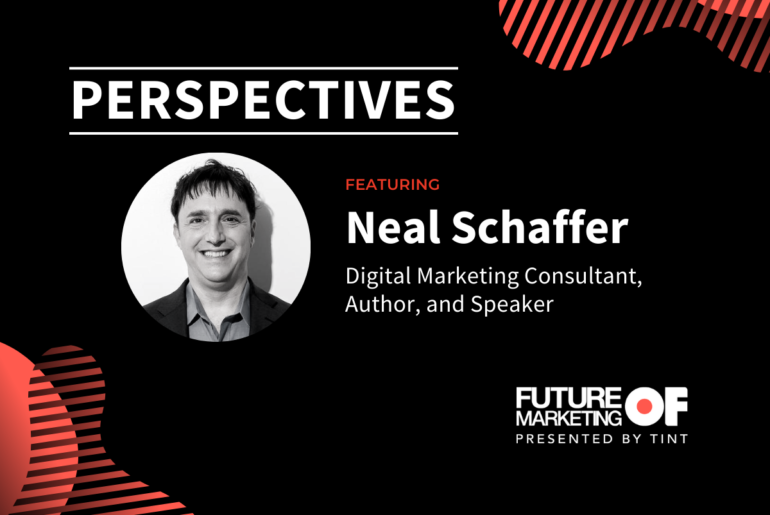Listen to the full episode on the podcast here.
Alicia Esposito is the VP of Content at Retail Touchpoints and Host of the podcast, Retail Remix. In her words, she shares:
- Repurposing content for maximum impact
- Struggles marketers face
- Why UGC resonates more with people than celebrity content
What do you do for a living? What does your day-to-day look like?
I’m the VP of Content for Retail Touchpoints. I’ve been with the company for 11 years now – started fresh out of college – and we started just as a website and a newsletter.
Over the years, it has very much evolved with our audiences, content preferences, and content consumption habits, so we essentially have what I would call a media ecosystem. That includes our digital content properties like our website and our newsletter, but also several video series, as well as our podcast, Retail Remix, and also events. We have seen a lot of success with our virtual events and we have an in-person event that is quickly scaling, so my day to day essentially includes ensuring consistency across all those properties and developing an always-on 365 content engagement model that is relevant for our audience, is engaging, and essentially can fuel each other.
So what I mean by that is how do we take a really well-received story on our website and turn that into something more. How do we turn it into a podcast series or episode? How do we turn it into an event session? So really finding ways to not just monetize, but optimize that content across all channels.
What’s been your biggest learning experience through all of this?
I think it’s just always looking for new opportunities.
I’m very lucky in that both our content teams, our editorial team, and our marketing teams, are always thinking a few steps ahead. And we also have a bit of an advantage because our sister brand is Demand Gen Report, which is a B2B marketing and technology site and publication.
They also have events, so we tap into that community to get some learnings, best practices, and trends. And we’ve also just been trying to figure out our own day-to-day behaviors, like how can we make this content more engaging for our audience? How can we essentially be anywhere they are?
We’re a small scrappy team and everyone is not above doing the work and figuring out how to do things. We also have a lot of folks who have a lot of different passions. So our VP of Digital Marketing also loves editing videos; we have folks in our demand gen team who also enjoy doing audio podcasts, so really finding those passion points and figuring out ways to hone them and use them to our advantage. I think that’s what drives us every day – addressing those opportunities for innovation.
When talking about your team… how small is small?
It’s interesting because we’re part of a much larger organization. Our parent company is Emerald, so we have a lot of different brands, but our editorial team is four people. I have two other people who spearhead the event content – like developing the agenda and positioning. And in our marketing team, we’re about like 8 to 10 people, which includes operations, copywriting, and our events. We do webinars and virtual events throughout the year, so that includes that team as well.
What blogs or resources do you tend to follow for your marketing news or insights?
My role falls into two different perspectives or lenses. I have the B2B marketing and content creation side of my life that has its own set of sources and newsletters and sites. And then I have the retail side, so I’ll share both and then, hopefully, people can get some valuable takeaways there, but for the content creation/marketing side of things: Demand Gen Report. Our sister brand is super valuable, especially because B2B is becoming more like B2C, so even for the B2C brands, you could probably get some helpful nuggets there.
Marketing Props is another fantastic site, just for a good mix of trends, best practices, data; Content Marketing Institute, Business to Community, and then I like to follow individuals who are driving that content on social media, especially LinkedIn because that’s where microblogging is happening. And it gets a little bit richer than Twitter in my opinion. So Ann Handley, Jason Miller is another really great marketer who used to be at LinkedIn, Microsoft, all these big brands, and Dave Gearhart, who’s really well-known in brand marketing.
For retail, I’m going to name-drop a few of the folks that I use as sources and they’re always great to piggyback some trends and insights off of – Melissa Gonzalez of the Lioness group. Lisa Amlani, who is a merchant turned retail consultant, Melissa Minkow of CI&T, Michelle Grant of Salesforce. They have that really rich combination of data, so they do a lot of research every day, they know what’s happening in the industry, and they also turn that into some great tips and best practices and really like to share real-life examples of brands that are doing things really well. And then those are the individuals, but there are so many other great sites and platforms that I turn to every day like CNBC, Vogue, Business of Fashion. We try to dip our toes into everything to see what’s happening.
What’s something interesting that you’ve learned in the last couple of years?
Lately, I’ve been digging a lot into inclusivity in retail in particular. We’ve been talking about it in marketing, I think for a bit longer. When you look at it through the lens of a consumer brand or a retailer, what does it really mean? And I think that’s a really existential question.
I think a lot of brands really need to be thinking about what this represents for us and what type of impact we want to make on the world. So an example is an apparel brand or retailer. We actually just ran a story today, an interview I did with an executive from Old Navy about their new inclusivity initiative, and it really encompasses everything. It’s not just the marketing content you create.
It’s not the models you hire. It’s the mannequins you use in the store. It’s how you design the store to be more inclusive. So all of their assortment and inventory are together; whereas, the petite section used to have the plus-size section. It creates this otherness in the store.
That is a bit you feel a bit isolated and like you don’t belong. So they’re transforming that not just in the store, but online. So it’s just been really fascinating to hear what is required. For true inclusivity and the customer experience and how can tech support it? How can marketing support it?
There have been some really really fascinating new developments in fit tech, like 3D imaging fit recommendations, and customization. So really seeing how all of these different pieces come together from essentially very different areas of the retail business come together to support this bigger mission.
What’s something that you feel that retailers, or brands in general, should stop doing on social media?
This is a tricky one because it’s difficult – social media is something that is so specific to that particular brand, and their particular audience. So I guess the big stop-doing is to stop trying to be everything for everyone and stop trying to be everywhere every time. I think it depends on your brand, like I said, and your target audience. There are specific touchpoints that are more worthwhile than others. And I’m not saying you can’t be everywhere to just test it out and see how your audience responds.
I think that is very important, but as far as allocating your time, your resources, any sort of investments into paid or social commerce – it’s important to know where your audience is and figure out what content most resonates with them and zero in on that. So I guess stop trying to be everything to everyone and stop trying to be everywhere all the time because it’s probably just going to drive your team nuts.
And I also see a lot of emphasis on hacks and quick wins as a result of that – but I’m seeing more and more that marketing experts are saying, wait, hacks allude to saying you’re beating the system or you’re trying to cheat something. Meaningful marketing means creating an experience that is engaging, immersive, and that’s differentiated across all of these channels.
I recall an executive who was doing the session about her brand’s TikTok strategy, and how it was such a big platform. She was in cosmetics, and TikTok is perfect for those types of brands. It’s all about creativity, video, and music and showing the product in action – like how to apply the product.
Her big lesson was to not simply reuse your TikTok content for different channels (or cross-post to Instagram just because it’s going to be a quick way to repurpose it or it’s going to be a cheat). Those platforms are very distinct. They’re unique and you have to understand what resonates for those different platforms.
What’s something that you feel all marketers need to start doing more of when it comes to social?
The one thing brands and retailers in particular need to start thinking about is how does the short form connect to the long-form – or how does visual connect to some different form of content, whether it’s written or whether it’s more long-form visual content.
Because I think a lot of folks learned that when Instagram [crashed] was what do we do now? And we just sat there refreshing the app. And I think it shows how important it is for brands to invest in their own properties for content creation. For example, if you use your Instagram to share customer spotlights or user-generated content… where else are you putting that content in the event that something else goes down? How can you create continuity between those two platforms?
It’s funny because for a few years we really saw this uptick in branded blogs or branded editorial, and then it went away for a little bit. Like it wasn’t discussed as much, but I feel like it’s starting to come back, especially in the direct-to-consumer space – so brands like Thinx, for example, which is really all about raising awareness in sustainable feminine care and having more open conversations around feminine care and period management.
Content is a really big piece of that puzzle and it helps raise awareness. It helps build trust. It helps build credibility for your brand. Use social media as a way to drive that engagement and that initial spark of education and empowerment and figure out how can you connect the dots between that first point to something deeper or another form of engagement on your own properties?
Why do you think it’s important for brands to invest in user-generated content?
Micro- and nano-influencers are really interesting because they have a very specific niche, or an area of focus. And they have a smaller community, sure, but they’re very engaged. I think that’s partly due to the fact that these influencers are just building their community. They’re not spread as thin; they’re not managing so many different platforms and partnerships. They have time to engage; they have time to respond; they have time to really nurture that community. So I think it’s the time they spend engaging in that relationship with their followers.
They feel like this person actually cares – like this is something that they use every day. Like they just feel like that added closeness that some people are not feeling as much with some of the big influencers because they know that there’s an operation behind all of that. So I think those smaller-scale influencers have a lot of clout and empowerment because of that. That focus is really important.
I interviewed an executive from E.L.F. beauty a while back and they were looking at women in gaming. They wanted to do a partnership and campaign through Twitch. And they thought, What gamers align with our values, which ones have those really tight-knit communities that we can tap into and create something really powerful? So looking for new inroads within different consumer groups.
As far as the value of UGC, overall, the power is in the context; brands can invest a lot of time and money creating their own content and doing photo shoots, but I think it’s the added layer of, okay, this person is like me. They live the way I do. They look the way I do. They go to the places that I go. And it creates that added level of empathy and connection. I can see how this could apply to me because the content that I’m looking at makes more sense to me.
It ties back to feeling like you see yourself in the brand, which again, ladders up to that inclusivity topic that we were talking about.
What do you feel most marketers tend to struggle with and how do you think they should face it?
We talked about it a little bit earlier around prioritizing. There are so many great platforms and new apps; anytime there’s a new outlet for us to possibly reach our audience that is getting a lot of traction and downloads, it’s like how do we hop on this? What’s our strategy for this?
It happened with Clubhouse. When it started, it was a very close-knit community of specific users. I got to hand it to them; they tapped into that exclusivity in a very strong way because everyone was talking about one, how do we get on it? And two, once we’re there, how do we build a strategy and community around it?
That’s effective and relevant for the brand. That’s really a big struggle – figuring out does this really make sense for our brand? How do we prioritize our time and our resources in the best possible way? And to that end, I think the tangential challenge is how do we get the most value out of the content we already have?
I’m a big proponent of repurposing, reusing, and breaking down content in different ways. You can get the most value possible out of that time investment that you’ve already made.
A good example is we do a lot of research reports, so taking out key data points and creating an infographic or creating a series of social images and using those as their own pieces of micro-content to drive buzz and downloads for the full report. I know that’s a little specific to publishing and B2B, but the same thing goes for the UGC example that we talked about. How can you reuse that content for display ads, for your product pages, for email campaigns? You can really take that one thing and turn it into something truly valuable – and driving results and engagement for your brand.
I think the final challenge that we’ve been talking about for years, and is still always present is the misalignment between peers in marketing content and sales. And again, it depends on your business structure and how you go to market. Like when you’re stuck in the day-to-day flow of that hamster wheel of okay, I have this deadline, I have to get this going to market, we have to do X, Y, Z; sometimes it’s challenging to take a step back and say, wait, hold on, before we launch this, let’s make sure that this aligns with the marketing plan. And can we use marketing’s resources to amplify this content or sales and marketing?
If marketing’s rolling out a campaign, how can we bring sales in the loop? Can they promote it to their database? And how does that all work? I think it’s the only way that everyone can stay aligned and rally towards a collective goal.
But again, especially over the past [2 years] with everyone working from home for the most part and still are, it’s that challenge of making sure everyone is aligned and everyone is clear on the goals of what’s happening and how are we all taking those steps to achieve those goals?
What is a book, person, or event that shaped your career and why?
There are so many creators doing so many different things now, so if I had to pick one for now – in the context of who I am and what I’m doing now – I love Kara Swisher, cohost of the Pivot Podcast. She’s the host of Sway. She does her own events. She leads the Vox Podcast Network. She writes for the New York Times – homegirl is literally everywhere. And when people summarize all of her accomplishments and everything she does, she’s just yeah, I’m a content person, I create content and I think she is one of those big journalistic figures who has been covering the tech space for a long time, has been covering business for a long time.
She’s always so true to that journalistic integrity and everything that she does. And she’s always asking the tough questions. She’s someone that people respect and are also a little scared of, and I commend her for that because I feel like especially in the media, there’s always been this emphasis of how do we get the most clicks? How do we get the most engagement? Even if that means not always doing the right thing or not always presenting information in the best possible way. And I feel like she’s always been laser-focused on educating the masses and getting to the heart of issues in a way that’s easily consumable for people.
And like I said, she’s just everywhere and I don’t know how she does it. I wish she would write a book about how to manage everything.
Who, where, or what do you tend to look for inspiration?
I love listening to podcasts and reading books about creativity and how to manage the creative demands with the pressures of every day. And I think it’s a combination of the tactical, like how to manage your time and like how to find time for ideas.
Writers and podcasters like Todd Henry are really good in that capacity, so he always balances getting the work done with how to make time to be creative. I also just finished Adam Grant’s new book, Think Again, which was so good because it’s all about the power of thinking like a scientist and not thinking you always have all of the [answers] all the time and not being ashamed to change your mind or rethink things.
And I think in marketing and content – we are pummeled by best practices and playbooks and things we should be doing and hacks. And there are a lot of people who claim to know all of the answers, but I think things are changing so rapidly that it’s important to just take a beat and say, okay, we may not know the answer to how this is going to go, but let’s try it and see what happens. And if it doesn’t work. That’s fine. We’ll just pick up and move forward.
And I’ve also been listening to Glennon Doyle’s podcast; it’s that personal little moment of connecting to oneself and balancing the emotional, the personal stuff with the professional stuff.
I have a three-and-a-half-year-old at home. So just like balancing the realities of juggling work and life and trying to be your best possible person across the board can take a toll. That’s just like my warm cup of coffee, so to speak. And sometimes I have it with coffee, but I just feel refreshed and really leveled after listening to that podcast.
What advice do you have for people or marketers or creatives who look up to you?
Keep creating. I know some days I feel like I don’t have another word in me. I’m like, I can’t, I don’t have any more ideas. Everything is rung from me. Be mindful of that. Embrace that, feel it, and take a step back if you need to.
I’m a big fan of stepping away – I need to go take a walk, this will be here when I’m back and it’ll be okay. But I’m also a big fan of just creating, even if the output is not going to be that great. Sometimes you just need to go through the motions and put things out there and just learn over time.
So, take your time and take breaks when you need them because it really helps. And then, when you feel like you just need to iterate and dabble in things and just figure it out, embrace that. It’s all part of the process.
And Handley has this process for writing – she’s a big proponent of getting it all on paper. I don’t know about you, but sometimes I feel like my head is swimming, the thoughts, and I get so stuck on making sure every sentence is perfect and structured.
She says to put it all down, just go with your heart, go with that creative flow. And you’ll actually be surprised by some of the things that come out of you. You may find that there’s some magic in those moments.
How do you wind down from a long day of work?
Definitely playing with my son. We have our own little nighttime routine where we play, we do bath, we read.
But I always make time to read as well, like for myself. Even if it’s just like 10 to 20 pages, it just helps me center and I guess take some time away from all of the screens. And I’m always trying to watch a show or something with my husband. We’re both big content people, he loves movies and TV and we, both, are big comedy buffs. So just taking that time to be together and just laugh.
What are you excited about or looking forward to?
I would say professionally, very excited. We are planning our next in-person event in May 2022, and we’re going through a lot of interviews and conversations with our community and past attendees – figuring out how to best position the experience.
We’re trying to do fun, new activations, experiences, and partnerships to really focus on the core of the community. We think in retail, especially, it’s all about the people. Like I know we cover the tech and the omni-channel and the social commerce and all of that fun stuff, but I think our conversation is a testament to the fact that even behind the digital touchpoints and the digital experience, it’s the people that power us and keep that machine going.





